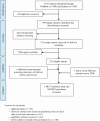The epidemiology of hepatitis C virus in Pakistan: systematic review and meta-analyses
- PMID: 29765698
- PMCID: PMC5936963
- DOI: 10.1098/rsos.180257
The epidemiology of hepatitis C virus in Pakistan: systematic review and meta-analyses
Abstract
To characterize hepatitis C virus (HCV) epidemiology in Pakistan and estimate the pooled mean HCV antibody prevalence in different risk populations, we systematically reviewed all available records of HCV incidence and/or prevalence from 1989 to 2016, as informed by the Cochrane Collaboration Handbook. This systematic review was reported following the PRISMA guidelines. Populations were classified into six categories based on the risk of exposure to HCV infection. Meta-analyses were performed using DerSimonian and Laird random-effects models with inverse variance weighting. The search identified one HCV incidence study and 341 prevalence measures/strata. Meta-analyses estimated the pooled mean HCV prevalence at 6.2% among the general population, 34.5% among high-risk clinical populations, 12.8% among populations at intermediate risk, 16.9% among special clinical populations, 55.9% among populations with liver-related conditions and 53.6% among people who inject drugs. Most reported risk factors in analytical epidemiologic studies related to healthcare procedures. Pakistan is enduring an HCV epidemic of historical proportions-one in every 20 Pakistanis is infected. HCV plays a major role in liver disease burden in this country, and HCV prevalence is high in all-risk populations. Most transmission appears to be driven by healthcare procedures. HCV treatment and prevention must become a national priority.
Keywords: Hepatitis C virus; Middle East and North Africa; epidemiology; incidence; prevalence.
Conflict of interest statement
The authors have no competing interests to declare.
Figures
Similar articles
-
The epidemiology of hepatitis C virus in Central Asia: Systematic review, meta-analyses, and meta-regression analyses.Sci Rep. 2019 Feb 14;9(1):2090. doi: 10.1038/s41598-019-38853-8. Sci Rep. 2019. PMID: 30765844 Free PMC article.
-
Systematic overview of hepatitis C infection in the Middle East and North Africa.World J Gastroenterol. 2018 Jul 21;24(27):3038-3054. doi: 10.3748/wjg.v24.i27.3038. World J Gastroenterol. 2018. PMID: 30038471 Free PMC article.
-
Characterization of the hepatitis C virus epidemic in Pakistan.BMC Infect Dis. 2019 Sep 14;19(1):809. doi: 10.1186/s12879-019-4403-7. BMC Infect Dis. 2019. PMID: 31521121 Free PMC article.
-
Hepatitis C virus viremic rate in the Middle East and North Africa: Systematic synthesis, meta-analyses, and meta-regressions.PLoS One. 2017 Oct 31;12(10):e0187177. doi: 10.1371/journal.pone.0187177. eCollection 2017. PLoS One. 2017. PMID: 29088252 Free PMC article. Review.
-
The prevalence of hepatitis C virus infection in β-thalassemia patients in Pakistan: a systematic review and meta-analysis.BMC Public Health. 2020 Apr 29;20(1):587. doi: 10.1186/s12889-020-8414-5. BMC Public Health. 2020. PMID: 32349737 Free PMC article.
Cited by
-
Expression Profiling of the Tripartite Motif Family Genes in Chronic Hepatitis C Patients.ACS Omega. 2023 Jul 7;8(28):25370-25377. doi: 10.1021/acsomega.3c02800. eCollection 2023 Jul 18. ACS Omega. 2023. PMID: 37483213 Free PMC article.
-
Elimination of HCV Infection: Recent Epidemiological Findings, Barriers, and Strategies for the Coming Years.Viruses. 2024 Nov 19;16(11):1792. doi: 10.3390/v16111792. Viruses. 2024. PMID: 39599906 Free PMC article. Review.
-
Seroprevalence of Hepatitis C Viral Infection in Ethiopia: A Systematic Review and Meta-Analysis.ScientificWorldJournal. 2021 Apr 9;2021:8873389. doi: 10.1155/2021/8873389. eCollection 2021. ScientificWorldJournal. 2021. PMID: 33897305 Free PMC article.
-
Hepatocellular Carcinoma in Asia: A Challenging Situation.Euroasian J Hepatogastroenterol. 2019 Jan-Jun;9(1):27-33. doi: 10.5005/jp-journals-10018-1292. Euroasian J Hepatogastroenterol. 2019. PMID: 31988864 Free PMC article. Review.
-
Microelimination of Hepatitis C in Thailand, Phetchabun Model: Progress, Challenges, and Future Directions.J Clin Med. 2025 Jun 3;14(11):3946. doi: 10.3390/jcm14113946. J Clin Med. 2025. PMID: 40507708 Free PMC article. Review.
References
-
- Stanaway JD, et al. 2016. The global burden of viral hepatitis from 1990 to 2013: findings from the Global Burden of Disease Study 2013. Lancet 388, 1081–1088. (doi:10.1016/S0140-6736(16)30579-7) - DOI - PMC - PubMed
-
- Chen SL, Morgan TR. 2006. The natural history of hepatitis C virus (HCV) infection. Int. J. Med. Sci. 3, 47 (doi:10.7150/ijms.3.47) - DOI - PMC - PubMed
-
- Rosen HR, Martin P. 2000. Viral hepatitis in the liver transplant recipient. Infect. Dis. Clin. 14, 761–784. - PubMed
-
- Lauer GM, Walker BD. 2001. Hepatitis C virus infection. N. Engl. J. Med. 345, 41–52. (doi:10.1056/NEJM200107053450107) - DOI - PubMed
-
- Bouvard V, et al. 2009. A review of human carcinogens—part B: biological agents. Amsterdam, The Netherlands: Elsevier.
Associated data
LinkOut - more resources
Full Text Sources
Other Literature Sources


